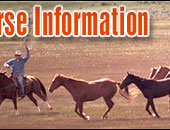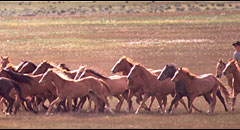 |
   |
|
|
|
You are here: Horses > Horse health > Chiropractic Care |
Equine Chiropractic Care Methods For Horses Are Increasingly Popular
Chiropractic care for horses is a controversial subject
within the community of equine aficionados and the
veterinarians who care for the animals. There are a host of
health problems that affect performance of the animals, yet
very often these conditions do not show up in the standard
tests or examinations which are administered to the horse. |
|
|
Animal owners and veterinarians who were at their witsí ends
successfully used chiropractic treatments on such animals,
leading the way for horse owners everywhere to introduce
chiropractic care to their equines. At other times,
diagnosed conditions were sought to be treated with
medicinal compounds, such as injections, anti-inflammatories,
muscle relaxants, and other substances, only to show little
if any effect on the animalís condition and overall health.
Once again, chiropractics have been used successfully in
some of these cases. |
You may be surprised to learn that the chiropractic
treatment of horses is similar to that of humans. The spinal
column is seen in both horses and humans as the primary
framework that helps the body to function properly and to
function without aches and pains. Thus, a misaligned spinal
column may be responsible for a lack of flexibility of the
neck and back as well as pinched nerves and painful spasms.
The spine itself is comprised of a number of vertebrae,
which are joined together to foster movement. If the spine
becomes improperly aligned, the joints will not move in the
manner they were designed to move, leading to stiffness,
pain, and other problems associated with movement.
A chiropractor refers to a misalignment of the spine as a
subluxation. A trained professional will be able to help
alleviate a large number of equine health problems with her
or his ministrations. Horse owners will usually call on the
services of such a professional when they notice that their
horse is less amicable to being saddled, to working or
jumping, or if they realize that the animalís head is tilted
at an odd angle, that there appears to be body stiffness,
and of course if the animalís back is sore. The causes for
such a subluxation may vary. The horse may be continuously
saddled with a poor fitting saddle. Or, perhaps the animal
was involved in an accident, such as a fall or being cast in
a stall. An inexperienced rider may have caused such an
injury, as may improver shoeing or even performance work
that is inappropriate for an individual horse.
Generally speaking, chiropractic adjustments will most
likely have to be repeated within a week or month to ensure
that the spine remains properly aligned. If the original
subluxation occurred because of an accident or injury, the
odds are good that the chiropractic treatment will need to
be repeated, as the problem may have become chronic. Some
horse owners have included chiropractic care as part of the
routine veterinary check up their animals receive.
If youíve ever wondered how a person can adjust the spine of
a strong, large animal, such as a horse, consider that many
modes of treatment for humans have been successfully adapted
for the use on horses. While it is possible to force the
adjustment, many practitioners have chosen to generate the
kind of motion for the horse that will make the adjustment
occur. This avoids the use of restraints and greatly
diminishes any discomfort the animal might experience.
Seasoned chiropractors will actually elicit something akin
to visible relaxation and enjoyment in the animals. Imagine
a horse listening to relaxing music while going through a
chiropractic adjustment!
To find a reputable chiropractor for your horse, you may
wish to ask around the circles of other horse aficionados.
Word spreads quickly when a good practitioner opens an
office. Yet no matter how highly recommended a chiropractor
may be, do take the time to ask about credentials, such as
training in animal chiropractics. The American Veterinary
Chiropractic Association actually offers a training course
for veterinarians who are interested in broadening their
practice. If an individual is not trained to perform
chiropractic care on animals, it is best to keep the person
out of your stable, since she or he can do much more harm
than good. Of course, no amount of chiropractic care will
replace a thorough veterinary exam, so it is important to go
there first if any problems arise. Once the subluxation of
the spine has been corrected, be sure to see if you can get
to the root of the cause, and then take steps to fix it.

|
Read the next horse health tips article on Equine Thermography. |
|
|
|
|
 |
|
|
|
|
|
Horse Education
|
|
|
|
|
Horse Information Topics
|
|
|
|
|
|
|
|
Horse Business Owners
|
| |
Advertise with Us
Have your horse products or services exposed to over 27,000 of our monthly visitors.
|
|
|
|
|
|